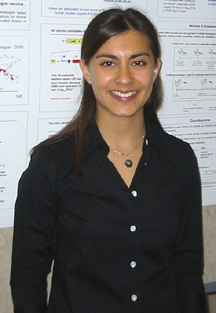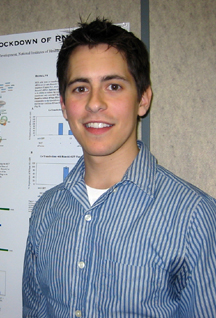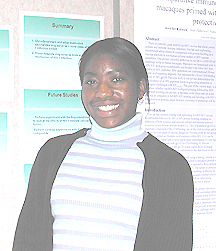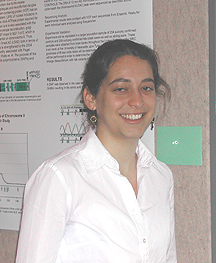From Virus to Vaccine: Creating a Live Attenuated Vaccine for Dengue, Type 2
Caroline
Agrawal, Boston University.
Preceptors:
Steve Whitehead
and Joseph
Blaney, NIAID, Laboratory
of Infectious Diseases
Dengue is a mosquito-borne virus with serotypes 1, 2, 3, and 4, which are prevalent in most of the tropical areas of the world. Dengue causes a flu-like illness that can result in severe or fatal complications when a previously infected individual encounters a secondary infection with a different serotype of the virus. No effective vaccines are currently available.
Agrawal was interested in designing a live attenuated vaccine strain of dengue virus in the laboratory primarily because of its immediate clinical applications. She adopted a reverse genetics approach, using PCR mutagenesis to modify the genome of a dengue serotype 2 strain in order to attenuate the virus.
She has been able to design two candidate vaccine strains: a dengue type 2 strain with a 30-nucleotide deletion in the 3'-UTR sequence (D-30) and a 3-nucleotide deletion in the NS3 viral protein that has both helicase and protease activities; and a dengue type 2/4 chimera that has the structural protein of a type 2 strain in a type 4 background in addition to two point substitutions in the NS5 polymerase protein.
The ability of these candidate vaccine strains to grow in Vero cells, the intended vaccine production cell line, was then assessed. Although the type 2/4 chimera candidate grew efficiently in these cells, Agrawal and colleagues were surprised to find that the type 2 D-30 strain with the single amino acid deletion in NS3 was unable to grow in these cells. Agrawal is currently exploring the possible reasons for this surprising finding.
In future studies, the candidate strains will be injected directly into human liver tumor cells in SCID mice to assess their level of attenuation. If these candidate strains show promise in the rodent model, they will be used to vaccinate rhesus monkeys prior to challenge with wild-type virus. The titer of neutralizing antibody in these monkeys and the development of significant viremia or side effects will be closely monitored. If these strains are attenuated in monkeys, they will be included in a tetravalent dengue vaccine formulation to be used in human clinical trials.
Agrawal plans to continue to study viruses during her graduate education at Duke University in Chapel Hill, N.C.
 |
|
Caroline
Agrawal
|


